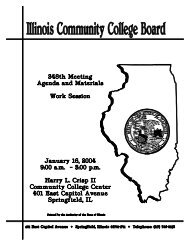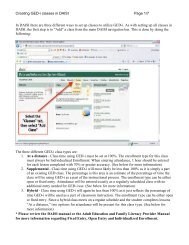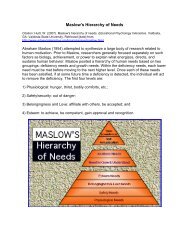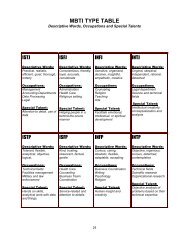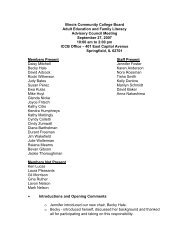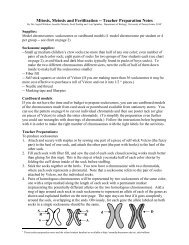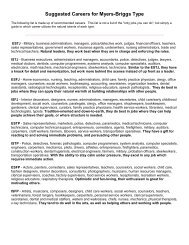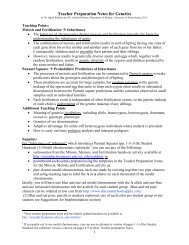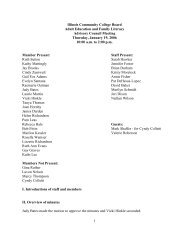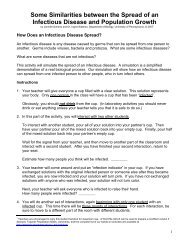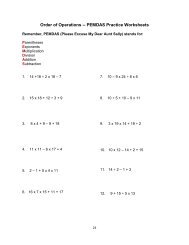Heinz's Dilemma Activity
Heinz's Dilemma Activity
Heinz's Dilemma Activity
Create successful ePaper yourself
Turn your PDF publications into a flip-book with our unique Google optimized e-Paper software.
PSYCHOLOGY IN ACTION<br />
Chapter 16: The forensic psychologist in the courtroom<br />
AGE & CRIMINAL RESPONSIBILITY<br />
Differences between minimum ages of criminal responsibility across countries around<br />
the world are partly explained by differing cultural and societal approaches, including<br />
the perceived usefulness of imposing criminal sanctions on children who may have an<br />
immature appreciation of the consequences or seriousness of their misbehaviour. In<br />
this regard, it is noteworthy that a substantial body of psychological research has<br />
assessed children’s development in “cognitive” (Piaget) and “moral” (Kohlberg)<br />
terms.<br />
Kohlberg developed a model, which attempted to explain how children develop a<br />
sense of right or wrong. To do this he posed several dilemmas to children of various<br />
ages and studied their responses. Teacher should read out aloud the following to the<br />
students:<br />
In Europe, a woman was near death from cancer. One drug might save her, a form of<br />
radium that a druggist in the same town had recently discovered. The druggist was<br />
charging $2,000, ten times what the drug cost him to make. The sick woman’s<br />
husband, Heinz, went to everyone he knew to borrow the money, but he could only get<br />
together about half of what it cost. He told the druggist that his wife was dying and<br />
asked him to sell it cheaper or let him to sell it cheaper or let him pay later. But the<br />
druggist said, “No.” The husband got desperate and broke into the man’s store to<br />
steal the drug for his wife. Should the husband have done that? Why?<br />
After the reading, the first step involves identifying and clarifying the dilemma. To do<br />
this the students must clarify their own notions of justice. This also might be the first<br />
opportunity for many students to think about issues, which they have heard but not<br />
really thought about.<br />
The second step involves reading the first part of the first question to the students.<br />
"Should Heinz steal the drug?" The students are asked to form three groups according<br />
to their answers: Those who think Heinz should steal the drug, those who think he<br />
should not, and those who cannot decide. Grouping helps students feel comfortable<br />
since it is easier to develop a sense of trust and cooperation in small groups. There can<br />
be more than one group within each group according to the number of students in the<br />
classroom. Next, dictate the remaining questions of the dilemma.<br />
1. Should Heinz steal the drug? Why or why not?<br />
2. If Heinz doesn't love his wife, should he steal the drug for her? Why or why<br />
not?<br />
3. Suppose the person dying is not his wife but a stranger. Should Heinz steal the<br />
drug for a stranger? Why or why not?<br />
Nicole Letch and Meral €ileli
PSYCHOLOGY IN ACTION<br />
Chapter 16: The forensic psychologist in the courtroom<br />
4. Suppose it is a pet animal he loves. Should Heinz steal to save the pet animal?<br />
Why or why not?<br />
5. Why should people do everything they can to save another's life?<br />
6. It is against the law for Heinz to steal? Does that make it morally wrong? Why<br />
or why not?<br />
7. Why should people generally do everything they can to avoid breaking the<br />
law? How does this relate to <strong>Heinz's</strong> case?<br />
Each group discusses and writes down the reasons in answer to the questions of the<br />
dilemma, then reports them back to the other groups.<br />
During this process, try to encourage students to find each other's perspective along<br />
with the perspectives of the people in the dilemma since role-taking is a prerequisite<br />
to the development of moral thinking. Also ask abstract philosophical questions such<br />
as, "Why are laws made? On what basis should one decide whether a law is just or<br />
unjust? If one decides to break a law intentionally, does a person have a responsibility<br />
to accept the consequences?" These questions invite students to explore the reasons<br />
behind their views and to interact with their classmates in a way that challenges their<br />
reasoning.<br />
What to expect<br />
Kohlberg's research in psychology has shown that our conception of<br />
justice-what is right-changes and develops over time as we interact with<br />
our environment. Students at the pre- conventional level approach a<br />
moral problem from the concrete interests of the individuals involved in<br />
a situation. Their concerns will be whether Heinz will be punished for<br />
stealing and whether he will be able to live without his wife.<br />
Students at the conventional level approach a moral problem as a<br />
member of society and take into account what the group or society<br />
expects an individual to do within its moral norms. The students'<br />
considerations at this level will focus on 1) whether a loving husband<br />
would do whatever he could to save his wife, 2) whether he could get<br />
help from the authorities and what would happen to society if all its<br />
members broke the laws. The concern is to protect society as well as<br />
one's own interests.<br />
At the post-conventional level a moral problem is considered from an<br />
above society perspective. The person at this level sees beyond the current<br />
laws and norms of society and thinks about the principles upon which a<br />
just society can be based. In relation to <strong>Heinz's</strong> dilemma, the person at the<br />
post-conventional level will consider whether the attempts to save a life<br />
would be interpreted as breaking the law. Another consideration would be<br />
to decide what kind of system could both prevent the loss of innocent life<br />
and protect the druggist's right to property.<br />
Nicole Letch and Meral €ileli
PSYCHOLOGY IN ACTION<br />
Chapter 16: The forensic psychologist in the courtroom<br />
A summary of Kohlberg’s findings in terms of age appropriate morality in relation<br />
to Heinz’s dilemma.<br />
Kohlberg’s Stages of Moral Development<br />
PRECONVENTIONAL<br />
Stage 1: Punishment orientation.<br />
Obedience to authority is considered.<br />
Example: “He shouldn’t steal the drug because he might get caught<br />
and be punished” (avoiding punishment)<br />
Stage 2: Pleasure-seeking orientation. Action is determined by one’s own<br />
needs. Example: “It won’t do him any good to steal the drug because<br />
his wife will be dead by the time he gets out of jail” (self-interest)<br />
CONVENTIONAL<br />
Stage 3:<br />
Stage 4:<br />
Good boy/good girl orientation. Action determined by the approval<br />
of their peer group. Example: “He shouldn’t steal the drug because<br />
others will think he is a thief. His wife will not want to be saved by<br />
stealing” (avoiding disapproval)<br />
Authority orientation. Should uphold the law at all costs. Follow<br />
social rules. Example: “Although his wife needs the drug, he should<br />
not break the law to get it. His wife’s condition doesn’t justify<br />
stealing” (traditional morality of authority)<br />
POSTCONVENTIONAL<br />
Stage 5:<br />
Stage 6:<br />
Social-contract orientation. Rules are open to question but are<br />
upheld for the good of the community. Example: “He should not steal<br />
the drug. The druggist response is unfair but mutual respect for the<br />
rights of others must be maintained.” (social contract)<br />
Morality of individual principles. High value is placed on justice,<br />
dignity, and equality. Example: “He should steal the drug but alert<br />
authorities he has done it. He will have to face a penalty, but he will<br />
save a human life.” (self-chosen ethical principles)<br />
Nicole Letch and Meral €ileli



